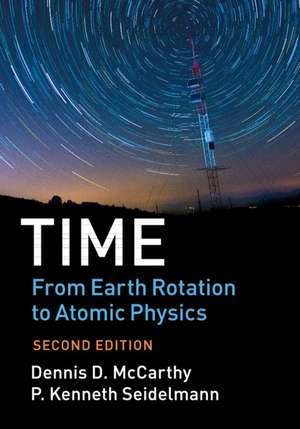Time: From Earth Rotation to Atomic Physics
Autor Dennis D. McCarthy, P. Kenneth Seidelmannen Limba Engleză Hardback – 17 oct 2018
Preț: 593.23 lei
Preț vechi: 666.55 lei
-11% Nou
Puncte Express: 890
Preț estimativ în valută:
113.52€ • 119.37$ • 93.80£
113.52€ • 119.37$ • 93.80£
Carte disponibilă
Livrare economică 27 martie-10 aprilie
Preluare comenzi: 021 569.72.76
Specificații
ISBN-13: 9781107197282
ISBN-10: 1107197287
Pagini: 400
Dimensiuni: 178 x 253 x 23 mm
Greutate: 0.95 kg
Ediția:2
Editura: Cambridge University Press
Colecția Cambridge University Press
Locul publicării:New York, United States
ISBN-10: 1107197287
Pagini: 400
Dimensiuni: 178 x 253 x 23 mm
Greutate: 0.95 kg
Ediția:2
Editura: Cambridge University Press
Colecția Cambridge University Press
Locul publicării:New York, United States
Cuprins
Preface; 1. Time: pre-twentieth century; 2. Solar time; 3. Ephemerides; 4. Variable Earth rotation; 5. Earth orientation; 6. Ephemeris time; 7. Relativity and time; 8. Time and cosmology; 9. Dynamical and coordinate time scales; 10. Clock developments; 11. Microwave atomic clocks; 12. Optical atomic standards; 13. Definition and role of a second; 14. International Atomic Time (TAI); 15. Coordinated Universal Time (UTC); 16. Time in the solar system; 17. Time and frequency transfer; 18. Modern Earth orientation; 19. International activities; 20. Time applications; 21. Future of time keeping; Acronyms; Glossary.
Recenzii
'Why do we add 1 second to our clocks at midnight at the end of some years, or at the end of June in others? Why don't we subtract 1 second sometimes instead? … You will find the answers to these and many more questions in this excellent book, written by two experts who worked on the practical aspects of these topics at the US Naval Observatory … The second edition brings these subjects right up to date, and investigates the possible future developments in timekeeping.' L. V. Morrison, The Observatory
Notă biografică
Descriere
This accessible reference presents the evolution of concepts of time and methods of time keeping, for historians, scientists, engineers, and educators.
